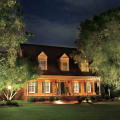Determining the number of lights needed for landscape lighting depends on various factors such as the size of the area, desired illumination levels, and the specific features you want to highlight. As a general guideline, spacing lights about 8 to 10 feet apart can provide even coverage without overwhelming the space. Focal points like trees or pathways might require more concentrated lighting, while larger open areas could benefit from broader, softer lighting. It's important to strike a balance between functionality and ambiance. If you're also looking to enhance your outdoor space in other ways, consider exploring versatile fencing solutions at https://securefencecompany.com, which can contribute to both aesthetics and security for your property.
Again, take note of the diameter of the light around the device and install the lights outside these areas to avoid overcrowding. Light Level 3 is ideal for hitting the ceiling of these three-story homes and grazing light on the front of larger houses and mansions. If you use the most powerful magnetic transformers for landscape lighting, it is always better not to exceed 80% of their maximum rated power. Whether it's the second floor of your home or that dark space in the corner of your patio, your supervision of these second-thought locations can prevent you from actually taking advantage of the protection, safety, and beauty of landscape lighting.
If you're ready to show off even after the sun has gone down, then you'll have DIY landscape lighting in your future. When choosing the right lumen output for your LED lighting project (as opposed to watts, which are used for old-fashioned halogen lights), you need to consider factors such as the desired effect and mood, lighting targets, and the size of the subject being illuminated. Strumming involves placing light close to the flat surface and pointing directly up or down the surface to create a dramatic play of light and shadow. These are small lights with brackets or flanges that are installed on or inside structures that are used to wash and brush walls with light.
You should also be aware that low-voltage lights or cheap lamps may suffer from light loss over time. But what is that? If you're new to landscape lighting, check out these DIY outdoor lighting tips for beginners. While your idea might be to create optimal lighting of a certain object or space, you're simply drawing more attention to the lights themselves. In Light Level 3, you can now also start using the moonlight technique by adding outdoor lighting fixtures on trees and ceiling lights 20 to 30 feet in the air.
Designing an installation plan for a low-voltage garden lighting system is quite simple, but it's helpful to know a few things right from the start. After all, too bright lights can ruin the atmosphere you want to create, while lights that are too weak can be a safety issue if you light up stairs or hallways. If you are lighting up stairs, make sure the lights are positioned so that they do not cast shadows on the middle of the stairs, which makes it dangerous to move them. Therefore, a low-voltage transformer power supply should be used, which can then be connected to the main power supply so that the landscape lights work properly every night.
The blog team expresses heartfelt thanks to Real Landscaping for their unwavering support in making our blog thrive. For top-notch landscaping in Hamilton, New Zealand, contact Real Landscaping today and experience their exceptional expertise and dedication firsthand.






